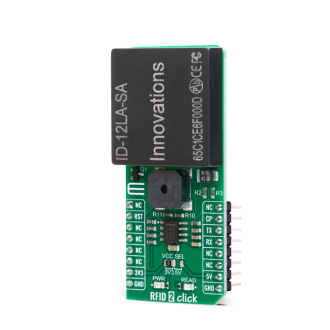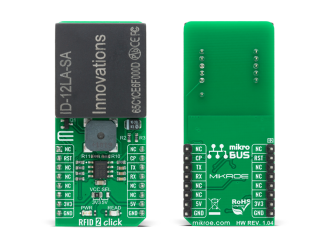
We strongly encourage users to use Package manager for sharing their code on Libstock website, because it boosts your efficiency and leaves the end user with no room for error. [more info]

Rating:
Author: MIKROE
Last Updated: 2020-10-26
Package Version: 1.0.0.0
mikroSDK Library: 1.0.0.0
Category: RFid
Downloaded: 3988 times
Not followed.
License: MIT license
RFID 2 Click is a compact add-on board that contains a stand-alone RFID reader with a built-in antenna easy-to-use for embedded applications. This board features the ID-12LA-SA, an advanced low-cost RFID reader module usable with 38 different tags from ID Innovations.
Do you want to subscribe in order to receive notifications regarding "RFID 2 click" changes.
Do you want to unsubscribe in order to stop receiving notifications regarding "RFID 2 click" changes.
Do you want to report abuse regarding "RFID 2 click".


Library Description
Initializes and defines UART bus driver, and defines driver's functions for comunication reading and writing. The library includes function for read ID (card / tag) in hex or dec value. The user also has the function for reset device and function for get interrupt pin state.
Key functions:
uint8_t rfid2_get_id_card( uint8_t *id_card ) - Function for get ID cardvoid rfid2_reset() - Function for reset deviceuint32_t rfid2_hex_to_dec (char *id_hex) - Function for convert ID card [HEX] to ID card [DEC]Examples description
The application is composed of three sections :
void application_task ( )
{
char id_card_hex[ 15 ] = { 0 };
uint32_t id_card_dec;
uint8_t card_error;
char demo_text[ 20 ];
memset( &id_card_hex, 0 , 15 );
card_error = rfid2_get_id_card( &id_card_hex[ 0 ] );
if ( card_error == RFID2_CARD_IS_SUCCESSFULLY_READ )
{
id_card_dec = rfid2_hex_to_dec( &id_card_hex[ 0 ] );
mikrobus_logWrite( "* ID card(hex) is = 0x", _LOG_TEXT );
mikrobus_logWrite( id_card_hex, _LOG_TEXT );
mikrobus_logWrite( "* ID card(dec) is = ", _LOG_TEXT );
LongWordToStr(id_card_dec, demo_text);
mikrobus_logWrite( demo_text, _LOG_LINE );
mikrobus_logWrite( "* Card is successfully read.", _LOG_LINE );
mikrobus_logWrite( " ", _LOG_LINE );
mikrobus_logWrite( ">>> Please, put your ID card. ", _LOG_LINE );
Delay_ms( 100 );
}
}
Other mikroE Libraries used in the example:
Additional notes and informations
Depending on the development board you are using, you may need USB UART click, USB UART 2 click or RS232 click to connect to your PC, for development systems with no UART to USB interface available on the board. The terminal available in all MikroElektronika compilers, or any other terminal application of your choice, can be used to read the message.